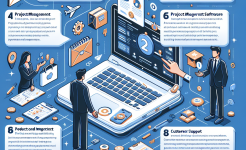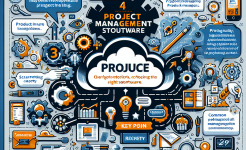Clear and Collaborative Communication
Effective communication is the cornerstone of agile development. In an agile environment, team members need to communicate openly, frequently, and clearly. This includes both verbal and written communication. Daily stand-up meetings are a crucial part of agile, where team members briefly share what they've accomplished, what they plan to do next, and any obstacles they're facing. This quick update keeps everyone on the same page and helps identify potential issues early.
Moreover, communication should not be limited to the development team. Stakeholders, including customers and product owners, need to be involved throughout the process. Regular feedback sessions and demos allow stakeholders to provide input, ensuring that the product being developed aligns with their expectations. By fostering a culture of collaboration and open communication, teams can avoid misunderstandings, reduce rework, and ultimately deliver a product that meets the needs of all parties.
In addition, using the right communication tools is essential. Tools like instant messaging platforms, project management software, and video conferencing tools facilitate seamless communication, especially in distributed teams. These tools enable real-time interaction, file sharing, and tracking of progress, enhancing the overall efficiency of the development process.
Continuous Planning and Adaptation
Agile development is characterized by its iterative and incremental nature. This means that planning is not a one-time activity but a continuous process. At the beginning of each sprint or iteration, the team plans the work to be done. This includes breaking down user stories into tasks, estimating the effort required, and assigning tasks to team members.
However, plans are not set in stone. As the development progresses, new information may emerge, or requirements may change. Agile teams need to be flexible and adapt their plans accordingly. This could involve reprioritizing user stories, adding or removing tasks, or even adjusting the scope of the sprint. By continuously planning and adapting, teams can ensure that they are always working on the most valuable tasks and delivering the maximum value to the customer.
Furthermore, retrospectives at the end of each sprint are a vital part of the continuous planning and adaptation process. During retrospectives, the team reflects on the sprint that has just ended, identifying what went well, what didn't go well, and what actions can be taken to improve. These insights are then used to inform the planning for the next sprint, leading to a continuous improvement cycle.
Empowered and Self-Organizing Teams
Agile development thrives on empowered and self-organizing teams. In an agile environment, teams are given the autonomy to make decisions about how they work. This includes deciding on the development processes, tools, and techniques they will use. By empowering teams, they can take ownership of their work and be more motivated to deliver high-quality results.

Self-organizing teams also have the ability to self-manage. They are responsible for coordinating their own work, resolving conflicts, and ensuring that the team is working towards the common goal. This does not mean that there is no leadership. Agile teams still need a leader, but the role of the leader is more of a facilitator and coach, rather than a traditional manager who dictates tasks.
To build empowered and self-organizing teams, organizations need to invest in training and development. Team members should be provided with the necessary skills and knowledge to work effectively in an agile environment. Additionally, creating a supportive and collaborative work culture is essential. When team members feel valued and respected, they are more likely to take initiative and contribute to the success of the team.
Focus on Customer Value
The ultimate goal of any software development project is to deliver value to the customer. In agile development, this focus on customer value is at the forefront. User stories are used to capture the requirements from the customer's perspective, describing what the customer wants to achieve and why it is valuable.
By prioritizing user stories based on their value to the customer, teams can ensure that they are working on the most important features first. This allows for early delivery of value to the customer, even if the product is not fully complete. In addition, continuous feedback from the customer helps the team to refine and improve the product, ensuring that it meets the customer's evolving needs.
Moreover, agile development emphasizes the delivery of working software in short iterations. This means that the customer can start using and benefiting from the product earlier. By getting the product into the hands of the customer quickly, the team can gather real-world feedback and make necessary adjustments, further enhancing the value of the product.
Quality Assurance throughout the Process
Quality is not an afterthought in agile development. Instead, it is integrated into every aspect of the development process. This starts with writing testable user stories. User stories should be clear, concise, and have acceptance criteria that can be used to verify whether the story has been successfully implemented.
During the development process, developers use techniques like test-driven development (TDD) and behavior-driven development (BDD). In TDD, tests are written before the code is developed, ensuring that the code meets the specified requirements. BDD takes this a step further by using natural language to describe the behavior of the system, making it easier for non-technical stakeholders to understand and participate in the testing process.
In addition, continuous integration and continuous delivery (CI/CD) pipelines are essential for maintaining quality. CI ensures that code changes are regularly integrated and tested, while CD automates the process of deploying the software to production. By automating these processes, teams can catch bugs early, reduce the time and effort required for manual testing, and ensure that the software is always in a deployable state.
In conclusion, implementing these five best practice guidelines - clear and collaborative communication, continuous planning and adaptation, empowered and self-organizing teams, focus on customer value, and quality assurance throughout the process - is crucial for the success of agile development projects. By following these guidelines, teams can improve their efficiency, deliver high-quality products, and better meet the needs of their customers. Agile development is not just a set of processes and techniques; it is a mindset that requires a commitment to collaboration, flexibility, and continuous improvement. Organizations that embrace this mindset and implement these best practices will be well-positioned to succeed in today's fast-paced and competitive business environment. It is important to note that these guidelines are not static, and teams may need to adapt them based on their specific context and requirements. However, by keeping these principles in mind, teams can navigate the challenges of agile development and achieve their goals. As the software development landscape continues to evolve, these best practices will remain relevant and essential for building successful software products.
ARTICLE TITLE :5 best practice guidelines for agile development model ,AUTHOR :ITpmlib

















